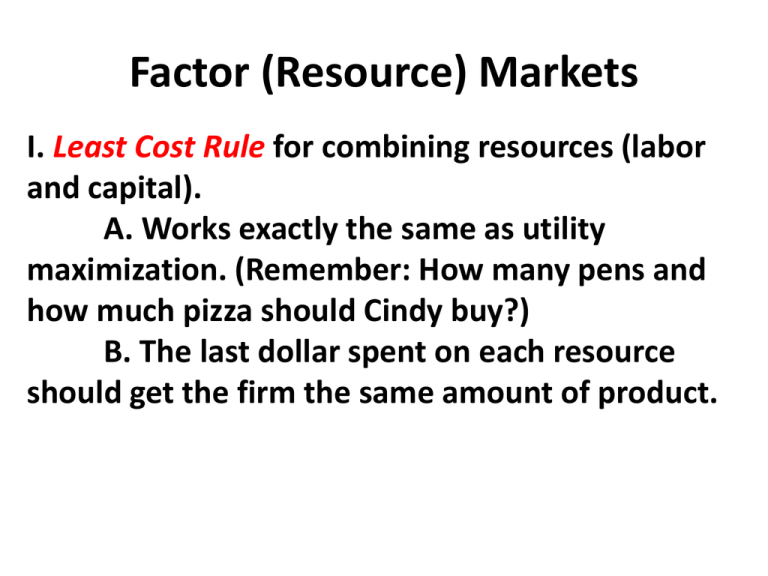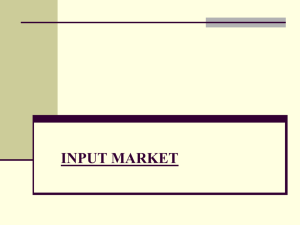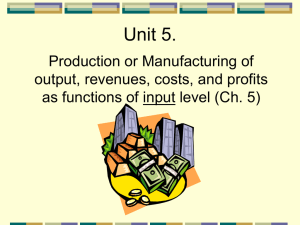a Copy
advertisement

Factor (Resource) Markets I. Least Cost Rule for combining resources (labor and capital). A. Works exactly the same as utility maximization. (Remember: How many pens and how much pizza should Cindy buy?) B. The last dollar spent on each resource should get the firm the same amount of product. What combinations of labor and capital will minimize costs? Labor (Price = $8) Capital (Price = $12) Quantity Total Product Marginal Product Marginal Product Per $ 0 0 0 0 0 0 0 0 1 12 12 1.5 1 13 13 1.08 2 22 10 1.25 2 22 9 0.75 3 28 6 0.75 3 28 6 0.5 4 33 5 0.625 4 32 4 0.33 5 37 4 0.5 5 35 3 0.25 6 40 3 0.375 6 37 2 0.17 7 42 2 0.25 7 38 1 0.08 Quantity Total Product Marginal Product Marginal Product Per $ What combination of labor and capital will minimize costs? Labor (Price = $8) Capital (Price = $12) Quantity Total Product Marginal Product Marginal Product Per $ 0 0 0 0 0 0 0 0 1 12 12 1.5 1 13 13 1.08 2 22 10 1.25 2 22 9 0.75 3 28 6 0.75 3 28 6 0.5 4 33 5 0.625 4 32 4 0.33 5 37 4 0.5 5 35 3 0.25 6 40 3 0.375 6 37 2 0.17 7 42 2 0.25 7 38 1 0.08 Quantity Total Product Marginal Product Marginal Product Per $ What combination of labor and capital will maximize profits? The price of the product is $2. Labor (Price = $8) MFC Capital (Price = $12) MRP Total Marginal Quantity Product Product Marginal Product MFC Quantity Total Product 0 0 0 0 MRP 0 0 0 0 1 12 12 8 24 1 13 13 12 26 2 22 10 8 20 2 22 9 12 18 3 28 6 8 12 3 28 6 12 12 4 33 5 8 10 4 32 4 12 8 5 37 4 8 8 5 35 3 12 6 6 40 3 8 6 6 37 2 12 4 7 42 2 8 4 7 38 1 12 2 What combination of labor and capital will maximize profits? The price of the product is $2. Labor (Price = $8) MFC Capital (Price = $12) MRP Total Marginal Quantity Product Product Marginal Product MFC Quantity Total Product 0 0 0 0 MRP 0 0 0 0 1 12 12 8 24 1 13 13 12 26 2 22 10 8 20 2 22 9 12 18 3 28 6 8 12 3 28 6 12 12 4 33 5 8 10 4 32 4 12 8 5 37 4 8 8 5 35 3 12 6 6 40 3 8 6 6 37 2 12 4 7 42 2 8 4 7 38 1 12 2 Profit Maximization: MRP = MFC (MRC) MFC is less than MRP MFC is greater than MRP (MRP) (MFC) For a firm in a perfectly competitive labor market, MFC is horizontal. MFC (MRC) MFC (Marginal Factor Cost) is the cost of hiring more labor. MRP (Marginal Revenue Product) is the benefit of hiring more labor. MRP III. Perfectly Competitive Labor Markets A. Work exactly the same as competitive product markets. B. Firms are wage-takers. They can hire all the workers they want at the market wage, but they can’t hire any workers for less than that. Wage rate A firm in a perfectly competitive labor market is a wage taker. What does this mean? Wc 0 The firm has no control over wages. It cannot pay lower wages without losing all of its employees, and it can hire all it wants at the market price, so it has no need to raise wages s = MFC above that. The supply curve, for the individual firm is d = MRP perfectly elastic. Q S W1 Wage Individual Firm Wage Industry W1 D Qi Quantity of Labor s = mfc d = mrp Qf Quantity of Labor III. Monopsonistic Labor Markets A. Work very much like monopolies, but with hiring labor instead of selling product. B. One firm hires all or most of the workers in a particular labor market. C. Firms are wage-makers. They must pay higher wages to employ additional workers. A monopsonist is a wage maker. Wage S W2 W1 0 Q1 What does this mean? Because the firm is the entire labor market, it decides employment levels for the entire market. It then sets wage based on the number of workers it wants to employ. The labor supply curve, for the monoposonist, is upward sloping. Q2 Quantity Wage For a monopsony, marginal factor cost (MFC or MRC) is always higher than wage. MFC Supply Wc Wm D = MRP 0 Qm Qc Quantity Quantity of Workers Wage Rate Total Factor Cost Marginal Factor Cost 1 $10 $10 $10 2 $11 $22 $12 3 $12 $36 $14 4 $13 $52 $16 5 $14 $70 $18 IV. Practice Problem (Hardest Multiple Choice) Let W denote the nominal wage, P the output price, and MPL the marginal product of labor. Which of the following relationships correctly estimates the marginal cost (MC) of production for a perfectly competitive firm in the short run? (A) MC = P/MPL (B) MC = P X MPL (C) MC = W X MPL (D) MC = W/MPL (E) MC = MPL/W IV. Practice Problem (Hardest Multiple Choice) It’s actually simple if you just think about it. If you hired the last worker at $30/hour and she could produce 5 baseballs per hour, what would be your marginal cost of baseballs at that level of production? $30/5 baseballs = $6 Marginal cost = Wage ÷ Marginal Product So here’s the multiple choice: Let W denote the nominal wage, P the output price, and MPL the marginal product of labor. Which of the following relationships correctly estimates the marginal cost (MC) of production for a perfectly competitive firm in the short run? (A) MC = P/MPL (B) MC = P X MPL (C) MC = W X MPL (D) MC = W/MPL (E) MC = MPL/W Marginal cost = Wage ÷ Marginal Product And if this were a perfectly competitive industry in long-run equilibrium, we could also say that: Price = wage/marginal product or ATC = wage/marginal product









